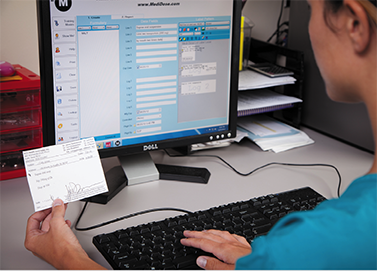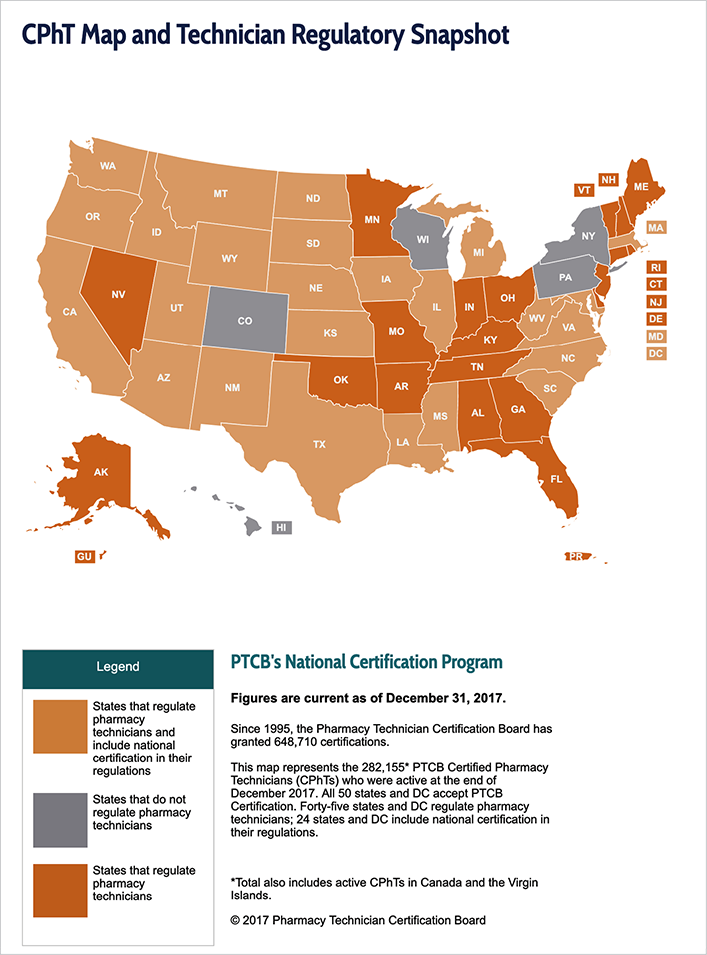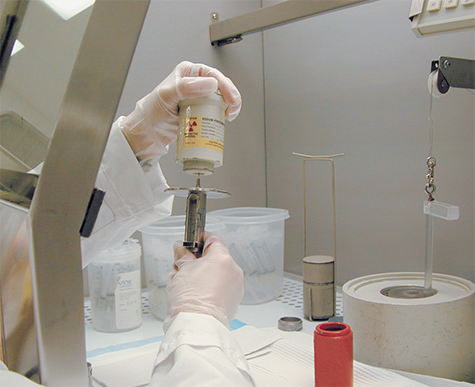1.6 The Roles and Responsibilities of a Pharmacy Technician
A pharmacy technician is an individual who has been trained to work under the oversight of a pharmacist to fullfill pharmacy activities that do not require the direct judgment of a pharmacist—for example, the physical assembling or compounding of a prescription. A central defining feature of the pharmacy technician’s job is accountability to the pharmacist. Technicians are not legally allowed to counsel a patient on medications or fill a prescription alone. Medication and dispensing errors—such as entering incorrect data from the prescription or selecting the wrong drug, dose, or dosage form—can cause serious reactions, and even death, if not detected. The pharmacist, then, takes final responsibility (and liability) for the pharmacy technician’s actions. However, a certified technician assists the pharmacist in checking and rechecking prescriptions to ensure accuracy and safety.

In recent years, both US News and World Report and Forbes have named pharmacy technicians in the “best jobs” categories for people trying to break into healthcare positions. They considered growing market demand, initial entry and upward mobility, median annual earnings, and opportunities to pursue part-time work in order to continue pursuing higher education.
The responsibilities of technicians vary according to the needs of the pharmacy workplace. The duties a technician may perform depend on education, state laws, and the workplace but may include the following:
input prescriptions in the computer system; check accuracy
prepare prescribed prescriptions—retrieve, weigh, pour, count, measure, and at times mix, count tablets, and label bottles
deliver medications to patients in some settings
engage with customers in answering phones, handling patient questions (not prescription-related), and referring patients to the pharmacist for medication counseling
contact physicians’ offices with refill requests and assist in safety/quality checks
act as a cashier, stock shelves, and handle inventory (sometimes handling procurement)
assemble patient medication profiles and histories; check them for accuracy
prepare online insurance claim forms, reconcile billing with copays and other insurance requirements
run automated equipment for high-volume drug processing and packaging
prepare nonsterile, sterile, and hazardous medications
in the hospital, work with the nursing staff, fill and deliver medication orders, repackage medications, and restock automated medication dispensing machines in the hospital floor units
prepare medication supplies in special packaging
 IN THE REAL WORLD
IN THE REAL WORLD
With expanding pharmacy patient care services and the increasing volume and complexity of pharmaceuticals, a certified technician graduating from an accredited program is an essential member of the healthcare team and an invaluable assistant in helping pharmacists provide medication services to patients and providers in all practice settings. The US Bureau of Labor Statistics forecasts a positive demand for pharmacy technician positions with 12% growth through 2026.
A Pharmacy Technician’s Education
Since 1983, ASHP has been responsible for the accreditation of pharmacy technician training programs. All the Department of Defense (DOD) military training programs for pharmacy technicians (or specialists) in all branches of the service are now ASHP-accredited. Pharmacy technician roles in the DOD are standardized and not subject to state pharmacy laws and regulations. There are currently over 250 accredited pharmacy technician programs in the United States, based mostly in vocational, technical, and community colleges. Approximately 12,000 students of accredited programs graduate each year, similar to the number of annual pharmacist graduates. As there is for pharmacists, there is also an oath of service for technicians. More information on an oath of service ethics and the professionalism of pharmacy technicians is in Chapter 15.

An important function of the pharmacy technician is to accurately input prescribed medications into the computer.
The ASHP-accredited coursework covers various topics:
introduction to practice
medical terminology
pharmacology
inpatient and outpatient dispensing procedures and record keeping
pharmacy calculations
sterile and nonsterile compounding techniques and aseptic techniques
pharmacy laws and regulations
communications, professionalism, and customer service
To learn more about the ASHP Model Curriculum, visit: https://PharmPractice7e.ParadigmEducation.com/ASHPModelCurriculum.
Figure 1.2 State Requirements for Pharmacy Technicians
As states make regulations for certification and licensing, most are requiring Pharmacy Technician Certification Board (PTCB) certification. A growing number, though, are allowing that of “another approved certifying agency,” which generally means the Exam for the Certification of Pharmacy Technicians (ExCPT). In a few states, such as Michigan, passing the modules and exams from a chain pharmacy store-approved program (such as from Walgreens, CVS, Meijer, Rite Aid, Kroger, Omnicare, and a few others), will suffice for a license. These certifications, however, may not be sufficient for hospital practice.

Credentialing of Pharmacy Technicians
According to a survey from the National Association of Boards of Pharmacy (NABP), the term pharmacy technician is now used in laws and regulations in 47 states and is also recognized in the provinces of Canada. Being a pharmacy technician today does not simply mean having a job in a pharmacy; rather, it is a chosen career path in which the technician is a recognized paraprofessional. Key to attaining that recognition is gaining the state-required credentials. (See Figure 1.2.)
A credential is simply a documented piece of evidence of one’s qualifications. Credentials for a pharmacy technician may include licensure, registration, and/or certification. However, the specific credential requirements to practice vary widely from state to state. The requirements for practice are set up by each state board of pharmacy.

The combination of classroom instruction, online learning, hands-on training, and independent study should help you pass the certification examination to earn your CPhT credential.
Since 2014, the Pharmacy Technician Accreditation Commission (PTAC)—a collaboration between the ASHP and the American Council on Pharmaceutical Education (ACPE)—was formed to review and accredit all future pharmacy technician education and training programs. This accrediting body utilizes the ASHP accreditation standards that went into effect in 2014 and follow the ASHP Model Curriculum. The content of this book has been designed to fit those standards and cover the essential topics in the field.
There are also numerous nonaccredited pharmacy technician training programs that vary in content, duration, and rigor. Nonaccredited pharmacy technician programs are often suited to fit the state’s requirements and local workplace and economic realities. Credentials for program graduates may include a certificate of completion or an associate degree. Professional pharmacy organizations, such as the ASHP, have long advocated for the development of uniform educational standards that follow a model curriculum to establish consistency among graduates. Consistency can build trust and encourage employers to offer greater responsibility and pay.
Canada has more consistency in technician training programs than the United States. The Pharmacy Examining Board of Canada sets the standards for all registered pharmacy technicians. The student must enroll in a program accredited by the Canadian Council for Accreditation of Pharmacy Programs (CCAPP). The student must also complete a structured field training program prior to being allowed to take an examination.
State Registration
In the majority of states, pharmacy technicians are required to be “registered,” or listed on the state’s official list of pharmacy technicians. Registration generally means that an individual must sign up with a state agency, such as the state board of pharmacy, before starting to practice in any licensed pharmacy. Pharmacy technicians who are not registered, or have allowed their registration to lapse, cannot legally work in a pharmacy in these states.

Certification examinations are taken online and are immediately scored. More and more states are requiring that technicians pass the examination to practice.
A majority of states also have training requirements, but are not yet standardized across the states. One of the main reasons for registration is to report and keep track of any serious disciplinary action (stealing drugs or money, etc.) before the disciplined technician applies for another pharmacy technician job or is hired at another pharmacy within or outside the state. If a technician changes employment within the state, they must notify the board of pharmacy. Registration cannot be reciprocated or transferred to another state. States have varying continuing education requirements for annual reregistration.
National Certification and Certification Exams
Some states require certification. Certification is the process by which a nongovernmental association grants recognition to an individual who has met certain predetermined qualifications specified by that profession. For pharmacy technicians, this requires passing an examination—either the Pharmacy Technician Certification Board (PTCB) Exam or the Exam for the Certification of Pharmacy Technicians (ExCPT)—and being awarded the title of Certified Pharmacy Technician (CPhT). Certification is like an academic degree and is generally valid and transferable to all states. If a CPhT moves to another state to practice, the CPhT credential would be valid, but the CPhT would be responsible for state registration and knowing and following the laws and continuing education requirements of the new state.
Pharmacy Technician Certification Exam (PTCE)
The most popular and recognized national certification is the Pharmacy Technician Certification Exam (PTCE), sponsored by the PTCB. The examination grew out of an effort by two states (Michigan and Illinois), the ASHP, and the American Pharmacy Association to develop technician standards. The board developed the PTCE based on task analyses of the actual work of pharmacy technicians in both the retail and hospital pharmacy settings. In 2001, the National Association of Boards of Pharmacy joined this effort to offer a certification program for pharmacy technicians.
 Pharm Fact
Pharm Fact
There are approximately 300,000 active CPhTs in practice in the United States, Canada, and the Virgin Islands.
The PTCE for pharmacy technician certification is recognized in all 50 states and the District of Columbia. Since 1995, the PTCB has granted nearly 650,000 certifications. PTCB recertification requires proof of completion of continuing education (20 hours over two years), especially in the areas of patient safety and pharmacy laws.
The Exam for Certification of Pharmacy Technicians (ExCPT)
An alternative test evolved out of the efforts of the National Community Pharmacists Association, National Association of Chain Drug Stores, and the National Healthcareer Association (NHA). The ExCPT is offered through the NHA. Although the examination is similar in content to the PTCE, it has more focus on community pharmacies and is not yet recognized in all states.
Clearly, there is a need for all states to have more consistency in technician training and examination requirements. The National Association of Boards of Pharmacy is working toward this goal in its Model State Pharmacy Act and Model Rules initiative for all states. To become PTCB-certified after 2020, technicians will have to graduate from an ASHP/ACPE-accredited program and successfully pass the PTCE. This is not too dissimilar from the requirements for pharmacist licensure, just at a different level.
State License
If a license (or in most cases, registration) is required for a pharmacy technician to practice in a state, the state board may require a national examination and certification plus passing an examination on state-specific pharmacy laws, graduating from an accredited program, and/or having experience. The state may also accept workplace training and registration in an official state registry. The state board of pharmacy should be consulted for specific state requirements.
The state board also makes the laws on the workload distribution and outlines the allowable ratio of pharmacists to technicians and the responsibilities of the technicians. For example, in South Carolina, a certified pharmacy technician is allowed to take down notes about a new prescription or refill a prescription over the phone and confirm it with the pharmacist; in most other states that must be done by the pharmacist. Many states stipulate a maximum ratio of technicians (including pharmacy interns) to pharmacists, which varies from 2:1 to 6:1. The ratio may be dependent on the number of certified pharmacy technicians employed at a site. Some states may use a higher technician-to-pharmacist ratio if at least one technician is certified.
 Practice Tip
Practice Tip
Check your state’s pharmacy technician requirements at the state website, or if your program has access to the latest edition, check the Survey of Pharmacy Law.
Workplace Credential Requirements
Community pharmacies increasingly expect their technicians to be certified by taking one of the technician certification examinations. Certification may be a requirement for initial employment (especially in large hospitals) or strongly encouraged within the first year of employment. The cost of taking the certification examination is commonly reimbursed by employers. There are often strong financial reasons for becoming certified. Hospital pharmacies require certification and will often expect prior experience or advanced training, especially if the technician will be working with sterile IV products and chemotherapy.

A pharmacy technician with a specialized certification in nuclear pharmacy prepares a sterile, radioactive medication using special equipment and protective shields.
To stay updated or certified, continuing education credits are required; topics may include managed healthcare, therapeutic issues, inventory control, patient interactions, pharmacy law, interpersonal skills, and drug distribution. Visit https://PharmPractice7e.ParadigmEducation.com/ASHP.
In specialized areas of practice—such as nonsterile compounding, sterile compounding, chemotherapy, or nuclear pharmacy—the pharmacy technician generally must have additional training. There will be more discussion on this throughout various chapters.